Spatial and Seasonal Dynamics of Water Environmental Capacity in Mountainous Rivers of the Southeastern Coast, China
Abstract
:1. Introduction
2. Study Area and Methods
2.1. Study Area
2.2. Hydrological Characteristics of Xian-Jiang Basin
2.3. Calculation and Allocation of Pollution Loads
2.4. Water Quality Response Models
2.4.1. Determination of Stream Segmentation and Hydraulic Characteristics
2.4.2. Hydrodynamic Process
2.4.3. Pollutant Degradation Process
2.4.4. Matrix Cacluation Algorithms
2.4.5. Water Environmental Capacity Calculation
3. Results and Discussion
3.1. Model Calibration and Verification
3.2. Contaminant Loadings Analyses
3.3. The Spatio-Temporal Analyses of Water Quality
3.4. The Temporal Variability of WEC in the Basin
3.5. The spatial Variability of WEC in Different Sub-Basins
4. Conclusions
Acknowledgments
Author Contributions
Conflicts of Interest
References
- Miao, M. Model and Enlightenment of economic development in coastal areas of China and Abroad. Econ. Rev. 2009, 8, 111–113. (In Chinese) [Google Scholar] [CrossRef]
- Singh, R.B.; Hales, S.; De Wet, N.; Raj, R.; Hearnden, M.; Weinstein, P. The influence of climate variation and change on diarrheal disease in the Pacific Islands. Environ. Health Perspect. 2001, 109, 155. [Google Scholar] [CrossRef] [PubMed]
- State Environmental Protection Administration of the China (SEPA). Environmental Quality Standards for Surface Water (GB3838-2002); China Environmental Science Press: Beijing, China, 2002. (In Chinese) [Google Scholar]
- Zhang, R.B.; Qian, X.; Zhu, W.T.; Gao, H.L.; Hu, W.; Wang, J.H. Simulation and Evaluation of Pollution Load Reduction Scenarios for Water Environmental Management: A Case Study of Inflow River of Taihu Lake, China. Int. J. Environ. Res. Public Health 2014, 11, 9306–9324. [Google Scholar] [CrossRef] [PubMed]
- Liu, Y.; Zou, R.; Riverson, J.; Yang, P.; Guo, H. Guided adaptive optimal decision making approach for uncertainty based watershed scale load reduction. Water Res. 2011, 45, 4885–4895. [Google Scholar] [CrossRef] [PubMed]
- Liu, R.M.; Sun, C.C.; Han, Z.X.; Huang, Q.; Chen, Y.X.; Gao, S.H.; Shen, Z.Y. Water environmental capacity calculation based on uncertainty analysis: A case study in the Baixi watershed area, China. Procedia Environ. Sci. 2012, 13, 1728–1738. [Google Scholar] [CrossRef]
- Zhang, Y.L.; Liu, P.Z. Comprehensive Manual of Water Environmental Capacity, 1st ed.; Tsinghua University Press: Beijing, China, 1991; ISBN 9787302009122. (In Chinese) [Google Scholar]
- Massachusetts Department of Environmental Protection. TMDLs—Another Step to Cleaner Waters. Available online: http://www.mass.gov/eea/agencies/massdep/water/watersheds/tmdls-another-step-to-cleaner-waters.html (accessed on 24 May 2017).
- Li, Y.X.; Qiu, R.Z.; Yang, Z.F.; Li, C.H.; Yu, J.S. Parameter determination to calculate water environmental capacity in Zhangweinan Canal Sub-basin in China. J. Environ. Sci. 2010, 22, 904–907. [Google Scholar] [CrossRef]
- Royer, T.C. On the effect of precipitation and runoff on coastal circulation in the Gulf of Alaska. J. Phys. Oceanogr. 1979, 9, 555–563. [Google Scholar] [CrossRef]
- Hoyos, C.D.; Webster, P.J. The role of intraseasonal variability in the nature of Asian monsoon precipitation. J. Clim. 2007, 20, 4402–4424. [Google Scholar] [CrossRef]
- Ning, S.K.; Chang, N.B.; Yang, L.; Chen, H.W.; Hsu, H.Y. Assessing pollution prevention program by QUAL2E simulation analysis for the Kao-Ping River Basin, Taiwan. J. Environ. Manag. 2001, 61, 61–76. [Google Scholar] [CrossRef] [PubMed]
- Cooter, W.S. Clean Water Act assessment processes in relation to changing US Environmental Protection Agency management strategies. Environ. Sci. Technol. 2004, 38, 5265–5273. [Google Scholar] [CrossRef] [PubMed]
- Dobbins, W.E. BOD and oxygen relationship in streams. J. Sanit. Eng. Div. 1964, 90, 53–78. [Google Scholar]
- Hosseini, N.; Chun, K.P.; Lindenschmidt, K.E. Quantifying spatial changes in the structure of water quality constituents in a large prairie river within two frameworks of a water quality model. Water 2016, 8, 158. [Google Scholar] [CrossRef]
- Park, S.S.; Lee, Y.S. A multiconstituent moving segment model for water quality predictions in steep and shallow streams. Ecol. Model. 1996, 89, 121–131. [Google Scholar] [CrossRef]
- Zhang, R.; Qian, X.; Yuan, X.; Ye, R.; Xia, B.; Wang, Y. Simulation of water environmental capacity and pollution load reduction using QUAL2K for water environmental management. Int. J. Environ. Res. Public Health 2012, 9, 4504–4521. [Google Scholar] [CrossRef] [PubMed]
- Lindenschmidt, K.E. The effect of complexity on parameter sensitivity and model uncertainty in river water quality modelling. Ecol. Model. 2006, 190, 72–86. [Google Scholar] [CrossRef]
- Fang, X.; Zhang, J.; Chen, Y.; Xu, X. QUAL2K model used in the water quality assessment of Qiantang River, China. Water Environ. Res. 2008, 80, 2125–2133. [Google Scholar] [CrossRef] [PubMed]
- Fan, C.; Ko, C.H.; Wang, W.S. An innovative modeling approach using Qual2K and HEC-RAS integration to assess the impact of tidal effect on River Water quality simulation. J. Environ. Manag. 2009, 90, 1824–1832. [Google Scholar] [CrossRef] [PubMed]
- Ningbo Municipal Water Conservancy Bureau. Water Information Annual Report of Ningbo in 2016. Available online: http://www.nbwater.gov.cn/News_view.aspx?ContentId=26058&CategoryId=15 (accessed on 8 June 2017). (In Chinese)
- Gu, C.; Hu, L.; Zhang, X.; Wang, X.; Guo, J. Climate change and urbanization in the Yangtze River Delta. Habitat Int. 2011, 35, 544–552. [Google Scholar] [CrossRef]
- Zhou, Y.; Fu, J.S.; Zhuang, G.; Levy, J.I. Risk-based prioritization among air pollution control strategies in the Yangtze River Delta, China. Environ. Health Perspect. 2010, 118, 1204. [Google Scholar] [CrossRef] [PubMed] [Green Version]
- Hsu, K.; Gupta, H.V.; Sorooshian, S. Artificial neural network modeling of the rainfall-runoff process. Water Resour. Res. 1995, 31, 2517–2530. [Google Scholar] [CrossRef]
- Luo, W.S.; Song, X.Y. Engineering Hydrology and Water Conservancy Calculation, 2nd ed.; China Water & Power Press: Beijing, China, 2010; ISBN 9787508474458. (In Chinese) [Google Scholar]
- Johnes, P.J. Evaluation and management of the impact of land use change on the nitrogen and phosphorus load delivered to surface waters: The export coefficient modelling approach. J. Hydrol. 1996, 183, 323–349. [Google Scholar] [CrossRef]
- Wu, Y.M.; Li, W.; Yu, Y.W.; Li, R.B.; Long, B.B.; Shi, J.Y. Non-point Source Pollution Loadings in Xitiaoxi. Watershed of Anji County, Zhejiang Province, China. J. Agro-Environ. Sci. 2012, 31, 1976–1985. (In Chinese) [Google Scholar] [CrossRef]
- Qian, X.H.; Xu, J.M.; Si, J.C.; Liu, X.M. Comprehensive survey and evaluation of agricultural nonpoint source pollution in Hang-Jia-Hu water-net plain. J. Zhejiang Univ. 2002, 28, 147–150. (In Chinese) [Google Scholar]
- Yan, L.Z.; Shi, M.J.; Wang, L. Review of agricultural non-point pollution in Taihu Lake and Taihu Basin. China Popul. Resour. Environ. 2010, 20, 99–107. (In Chinese) [Google Scholar] [CrossRef]
- Fetter, C.W. Applied Hydrogeology, 4th ed.; Prentice Hall: Upper Saddle River, NJ, USA, 2000; pp. 58–65. ISBN 978-0130882394. [Google Scholar]
- Gordon, N.D.; McMahon, T.A.; Finlayson, B.L.; Gippel, C.J.; Nathan, R.J. Stream Hydrology: An Introduction for Ecologists, 2nd ed.; Wiley: Hoboken, NJ, USA, 2004; ISBN 0470843578. [Google Scholar]
- Ding, Y.; Jia, Y.; Wang, S.S. Identification of Manning’s roughness coefficients in shallow water flows. J. Hydraul. Eng. 2004, 130, 501–510. [Google Scholar] [CrossRef]
- Fu, G.W. Mathematical Model of River Water Quality and Its Simulation, 1st ed.; China Environmental Science Press: Beijing, China, 1987; pp. 67–146. ISBN 7-80010-002-2/X0012. (In Chinese) [Google Scholar]
- White, J.D.; Dracup, J.A. Water quality modeling of a high mountain stream. Water Pollut. Control Fed. 1977, 49, 2179–2189. [Google Scholar]
- Launay, M.; Le Coz, J.; Camenen, B.; Walter, C.; Angot, H.; Dramais, G.; Faure, J.B.; Coquery, M. Calibrating pollutant dispersion in 1-D hydraulic models of river networks. J. Hydro-Environ. Res. 2015, 9, 120–132. [Google Scholar] [CrossRef]
- Aksoy, H.; Kavvas, M.L. A review of hillslope and watershed scale erosion and sediment transport models. Catena 2005, 64, 247–271. [Google Scholar] [CrossRef]
- Li, X.L.; Yao, J.; Zhang, J.; Zhao, S. A comparative study of assimilative capacity for different pollution control modes in a river. Environ. Sci. Technol. 2011, 34, 144–148. (In Chinese) [Google Scholar] [CrossRef]
- Černý, V. Thermodynamical approach to the traveling salesman problem: An efficient simulation algoritm. J. Optim. Theory Appl. 1985, 45, 41–51. [Google Scholar] [CrossRef]
- Putnam, H. Trial and error predicates and the solution to a problem of Mostowski. J. Symb. Log. 1965, 30, 49–57. [Google Scholar] [CrossRef]
- Goovaerts, P. Geostatistical modelling of uncertainty in soil science. Geoderma 2001, 103, 3–26. [Google Scholar] [CrossRef]
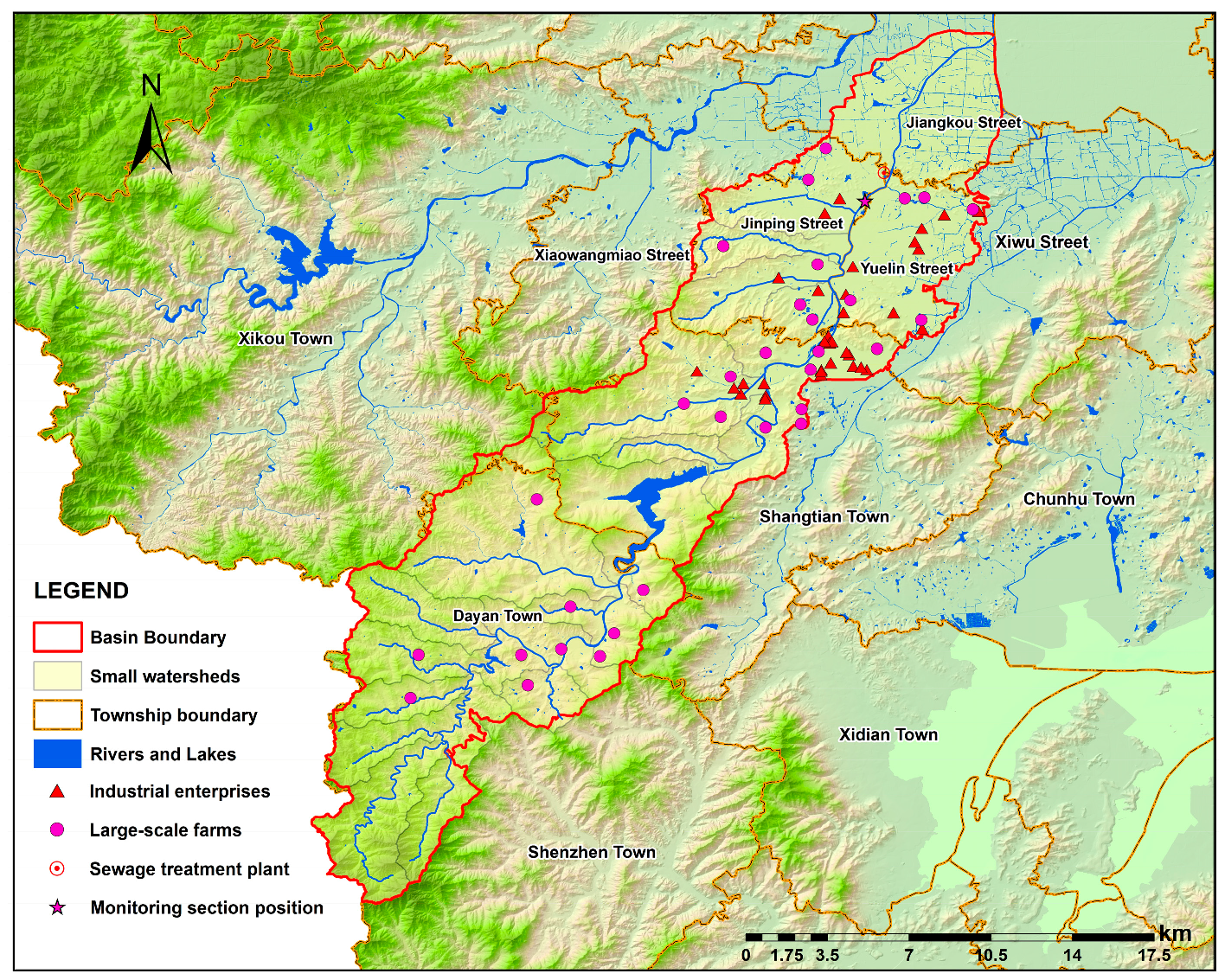

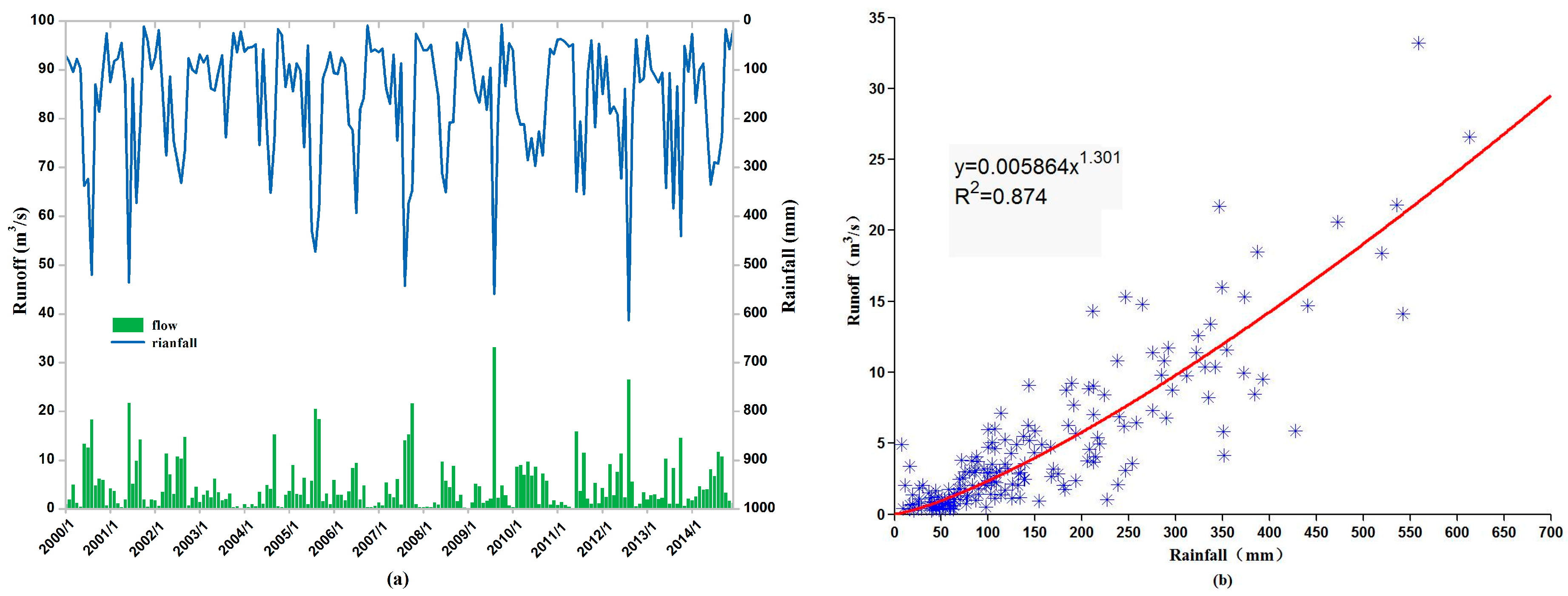
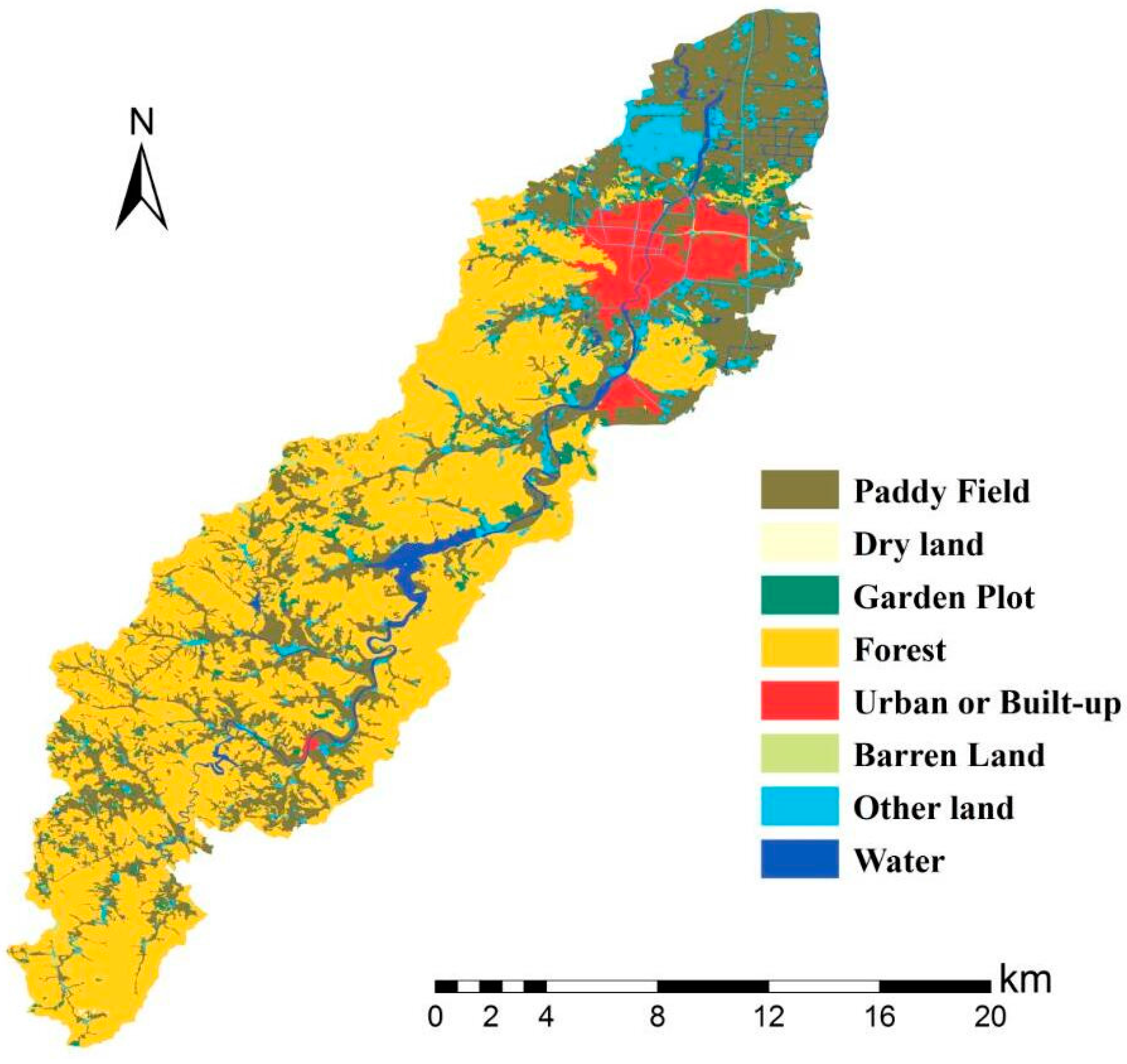
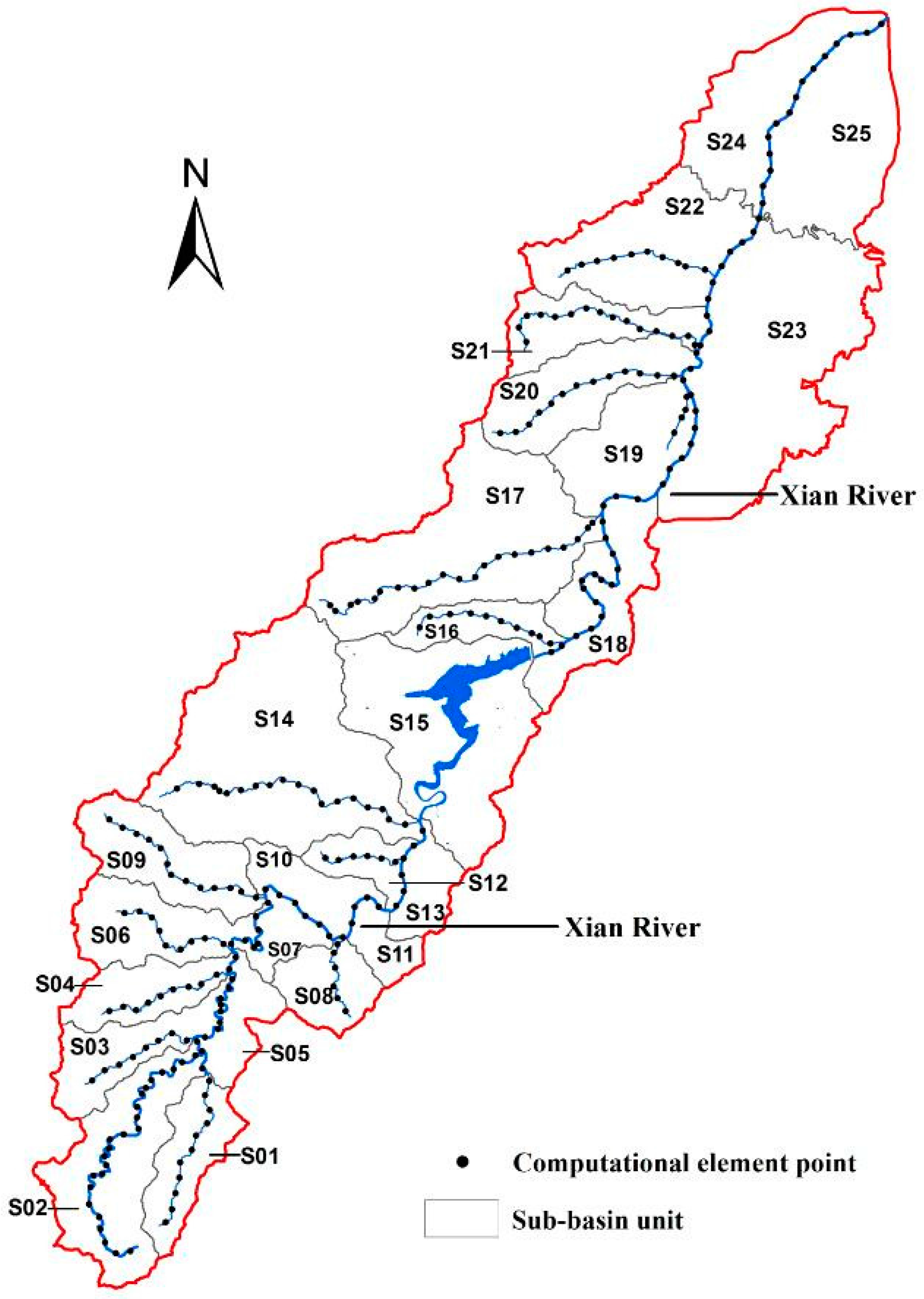

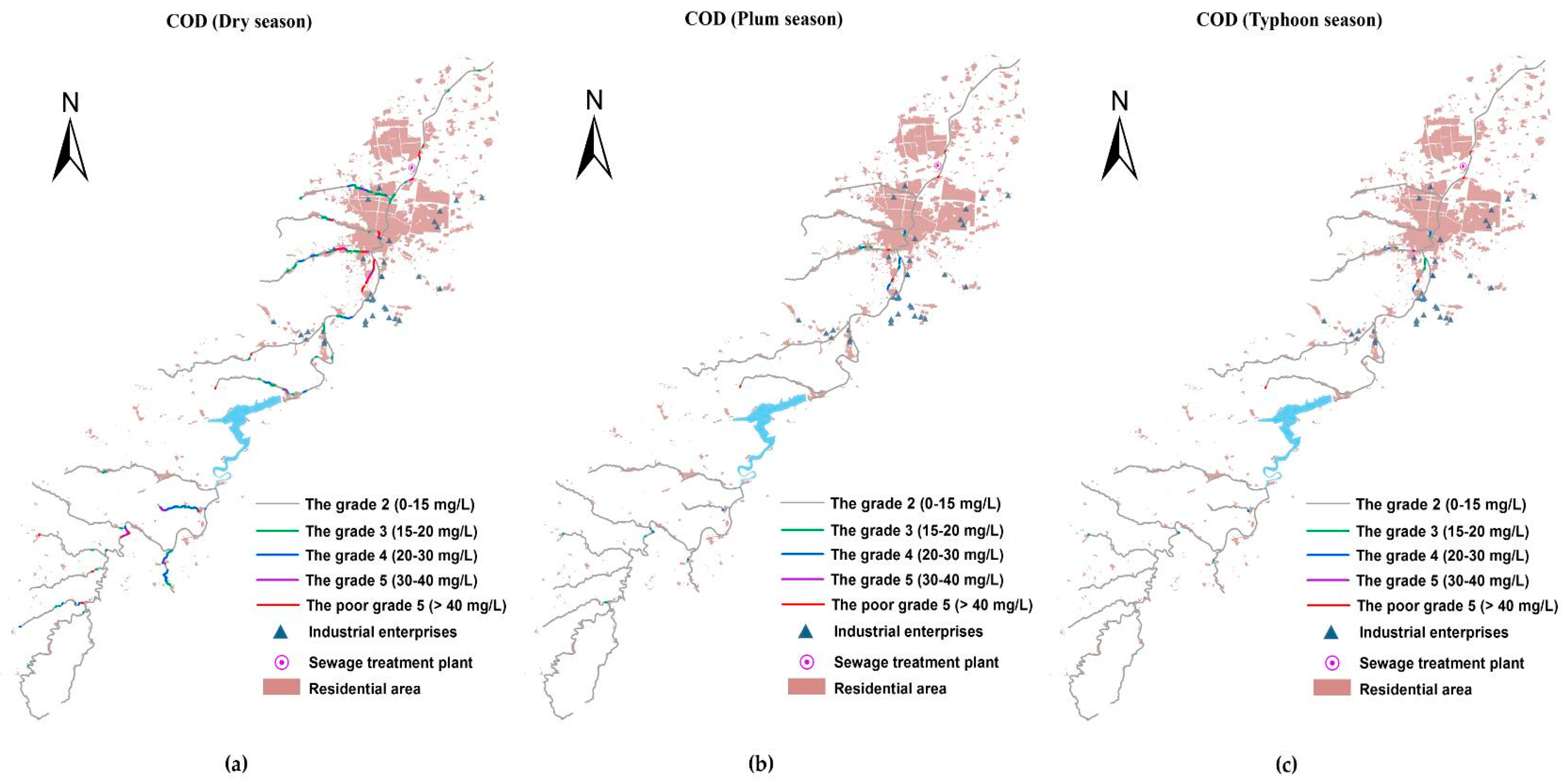
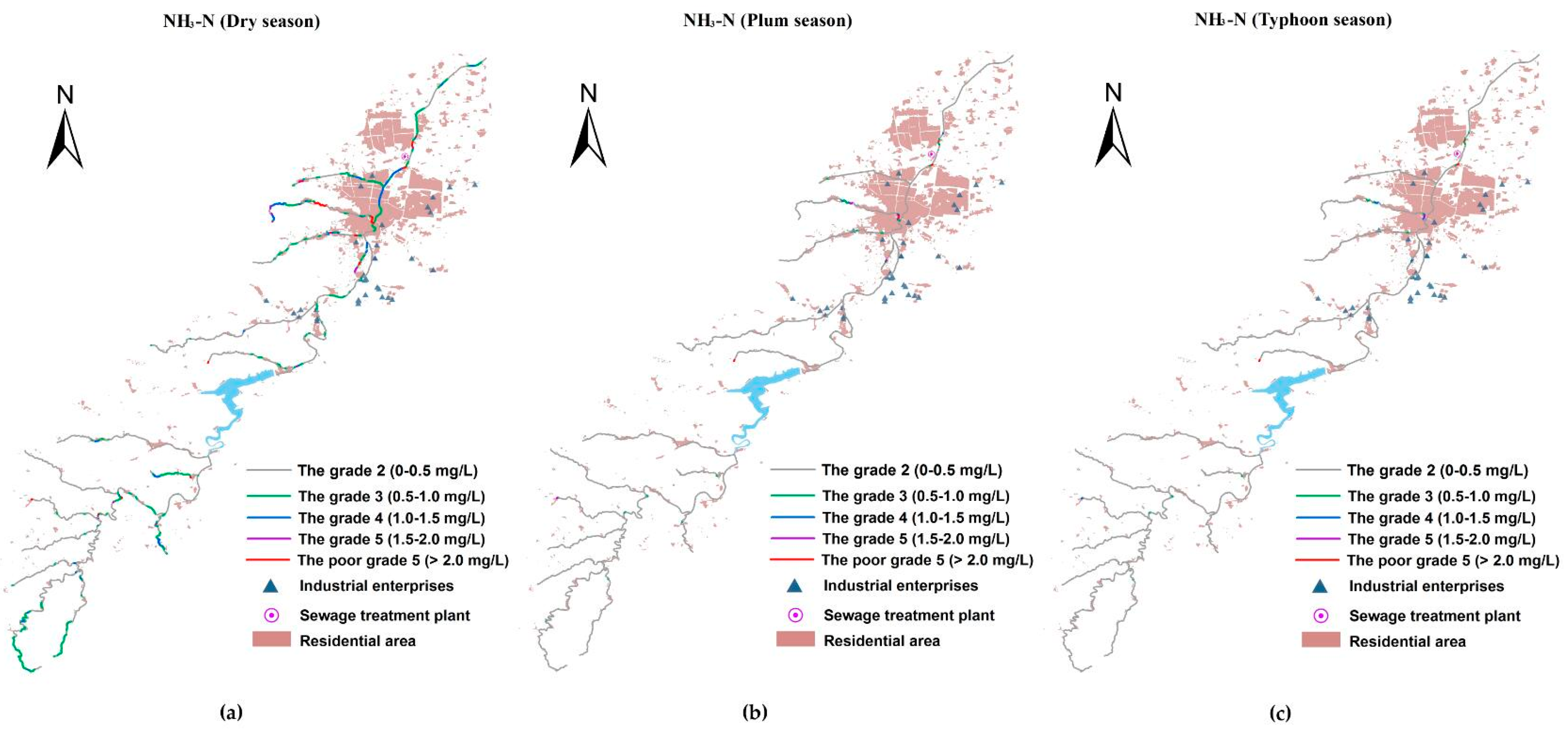
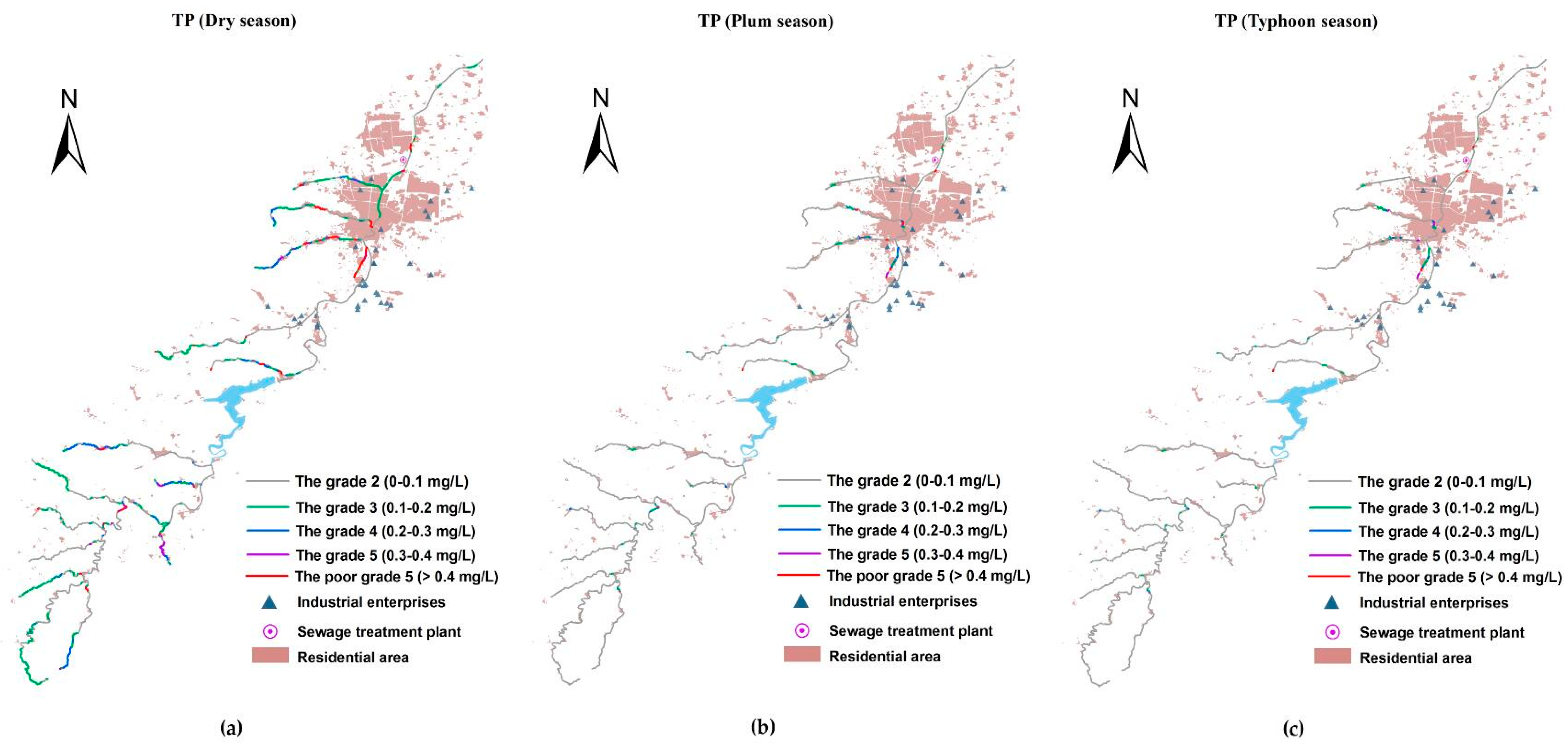
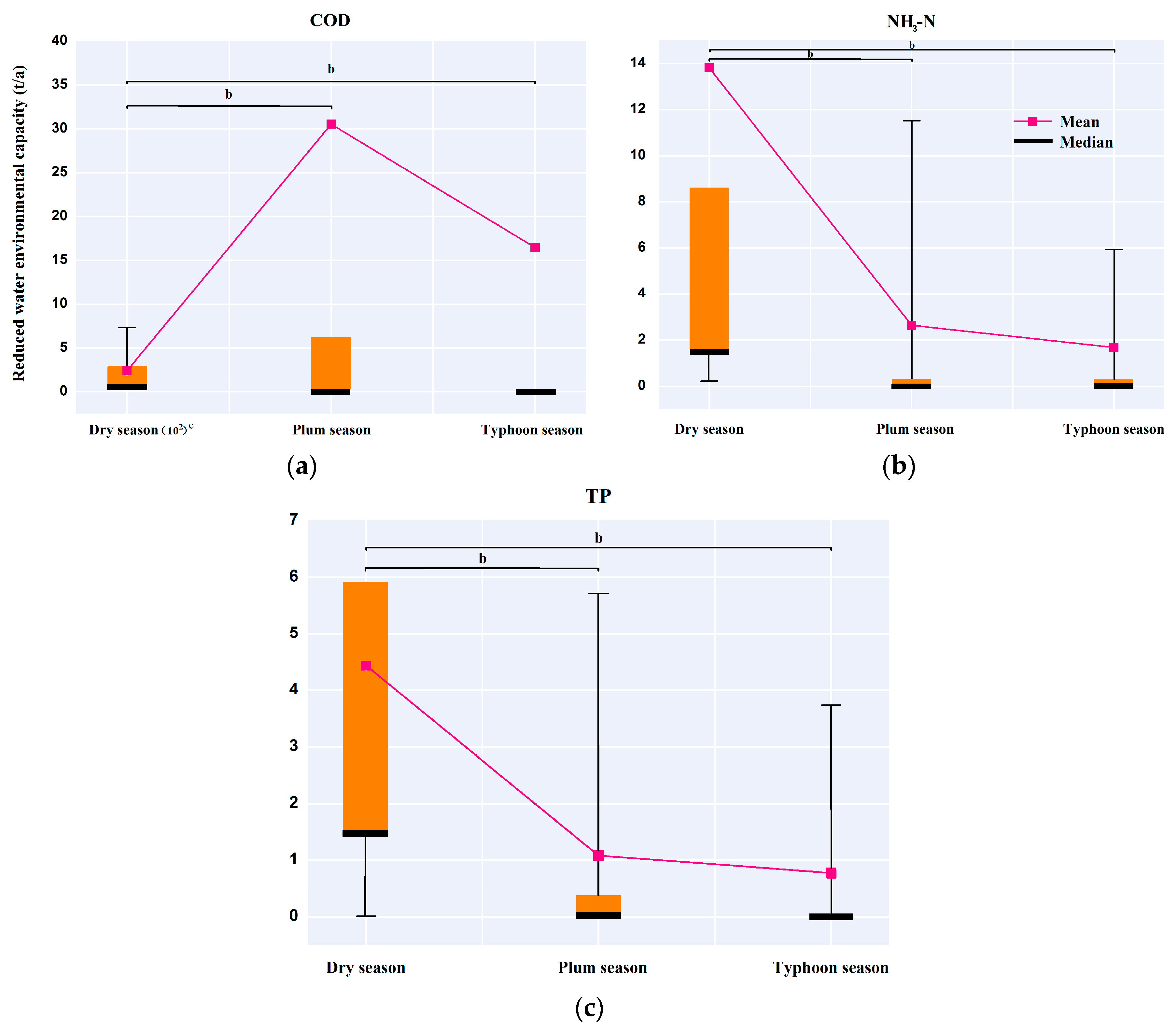

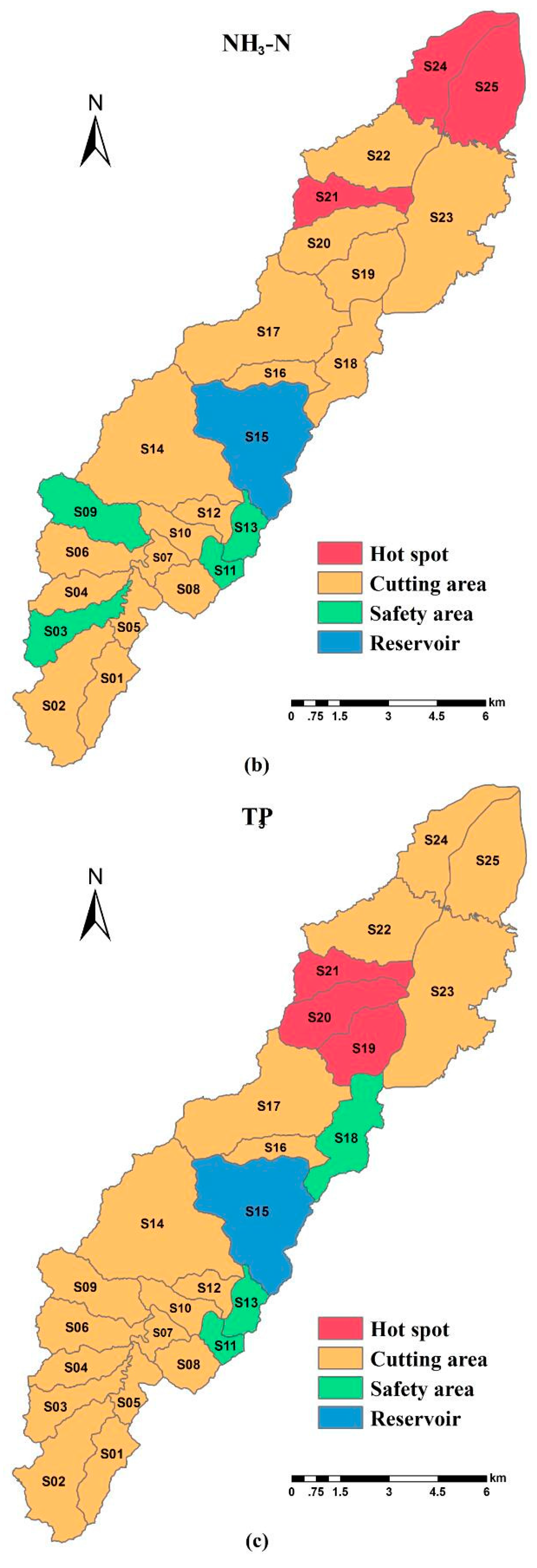
| Pollution Sources | COD | NH3-N | TP | |||
|---|---|---|---|---|---|---|
| (t/a) | (%) | (t/a) | (%) | (t/a) | (%) | |
| Agricultural Non-point source | 1188.78 | 17.69 | 46.03 | 9.43 | 24.86 | 19.34 |
| Formalization cultivation | 204.25 | 3.04 | 22.06 | 4.52 | 12.35 | 9.61 |
| Domestic sewage | 4519.20 | 67.25 | 388.96 | 79.69 | 76.01 | 59.02 |
| Industrial enterprises | 65.68 | 0.98 | 4.74 | 0.97 | 0.31 | 0.33 |
| Wastewater treatment plant | 741.77 | 11.04 | 26.33 | 5.39 | 15.04 | 11.70 |
| Total | 6719.68 | 100.00 | 488.12 | 100.00 | 128.57 | 100.00 |
| Sub-Basin 1 | S01 | S02 | S03 | S04 | S05 | S06 | S07 | S08 | S09 | S10 | S11 | S12 |
|---|---|---|---|---|---|---|---|---|---|---|---|---|
| Area | 7.61 | 16.33 | 8.04 | 6.79 | 4.77 | 9.64 | 3.47 | 6.01 | 10.84 | 5.27 | 3.12 | 4.00 |
| COD 2 | 0.00 | 0.23 | 6.05 | 8.28 | 0.00 | 1.41 | 50.46 | 46.58 | 1.19 | 0.00 | 0.00 | 32.21 |
| NH3-N 2 | 0.42 | 0.01 | 0.00 | 0.12 | 0.05 | 0.07 | 1.07 | 1.23 | 0.00 | 0.21 | 0.00 | 0.46 |
| TP 2 | 0.17 | 0.20 | 0.16 | 0.08 | 0.07 | 0.06 | 0.93 | 0.56 | 0.07 | 0.16 | 0.00 | 0.36 |
| Sub-Basin | S13 | S14 | S16 | S17 | S18 | S19 | S20 | S21 | S22 | S23 | S24 | S25 |
| Area | 4.42 | 34.55 | 5.20 | 27.50 | 11.60 | 10.83 | 11.59 | 8.21 | 16.95 | 33.28 | 13.11 | 17.69 |
| COD 2 | 0.00 | 0.25 | 10.37 | 4.07 | 0.99 | 132.95 | 109.50 | 79.79 | 7.12 | 3.49 | 41.40 | 41.40 |
| NH3-N 2 | 0.00 | 0.12 | 0.08 | 0.02 | 0.02 | 0.79 | 0.92 | 9.69 | 0.20 | 1.58 | 4.94 | 4.94 |
| TP 2 | 0.00 | 0.33 | 0.40 | 0.08 | 0.00 | 2.07 | 1.55 | 2.07 | 0.09 | 0.04 | 0.45 | 0.45 |
| Contaminants | N | Range 1 | Min 1 | Max 1 | Mean 1 | Median 1 | SD | CV/% |
|---|---|---|---|---|---|---|---|---|
| COD | 24 | 132.95 | 0.00 | 132.95 | 24.07 | 5.06 | 37.07 | 154.01 |
| NH3-N | 24 | 9.69 | 0.00 | 9.69 | 1.12 | 0.16 | 2.28 | 203.57 |
| TP | 24 | 2.07 | 0.00 | 2.07 | 0.43 | 0.17 | 0.61 | 141.86 |
© 2018 by the authors. Licensee MDPI, Basel, Switzerland. This article is an open access article distributed under the terms and conditions of the Creative Commons Attribution (CC BY) license (http://creativecommons.org/licenses/by/4.0/).
Share and Cite
Liu, Q.; Jiang, J.; Jing, C.; Qi, J. Spatial and Seasonal Dynamics of Water Environmental Capacity in Mountainous Rivers of the Southeastern Coast, China. Int. J. Environ. Res. Public Health 2018, 15, 99. https://doi.org/10.3390/ijerph15010099
Liu Q, Jiang J, Jing C, Qi J. Spatial and Seasonal Dynamics of Water Environmental Capacity in Mountainous Rivers of the Southeastern Coast, China. International Journal of Environmental Research and Public Health. 2018; 15(1):99. https://doi.org/10.3390/ijerph15010099
Chicago/Turabian StyleLiu, Qiankun, Jingang Jiang, Changwei Jing, and Jiaguo Qi. 2018. "Spatial and Seasonal Dynamics of Water Environmental Capacity in Mountainous Rivers of the Southeastern Coast, China" International Journal of Environmental Research and Public Health 15, no. 1: 99. https://doi.org/10.3390/ijerph15010099





